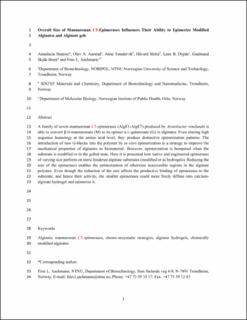Overall size of mannuronan C5-Epimerases influences their ability to epimerize modified alginates and alginate gels
Stanisci, Annalucia; Aarstad, Olav Andreas; Tøndervik, Anne; Sletta, Håvard; Dypås, Lene Brattsti; Skjåk-Bræk, Gudmund; Aachmann, Finn Lillelund
Peer reviewed, Journal article
Accepted version
Permanent lenke
https://hdl.handle.net/11250/2721038Utgivelsesdato
2018Metadata
Vis full innførselSamlinger
- Publikasjoner fra CRIStin - SINTEF AS [5801]
- SINTEF Industri [1565]
Sammendrag
A family of seven mannuronan C5-epimerases (AlgE1-AlgE7) produced by Azotobacter vinelandii is able to convert β-d-mannuronate (M) to its epimer α-l-guluronate (G) in alginates. Even sharing high sequence homology at the amino acid level, they produce distinctive epimerization patterns. The introduction of new G-blocks into the polymer by in vitro epimerization is a strategy to improve the mechanical properties of alginates as biomaterial. However, epimerization is hampered when the substrate is modified or in the gelled state. Here it is presented how native and engineered epimerases of varying size perform on steric hindered alginate substrates (modified or as hydrogels). Reducing the size of the epimerases enables the epimerization of otherwise inaccessible regions in the alginate polymer. Even though the reduction of the size affects the productive binding of epimerases to the substrate, and hence their activity, the smaller epimerases could more freely diffuse into calcium-alginate hydrogel and epimerize it.
Utgiver
ElsevierTidsskrift
Carbohydrate PolymersOpphavsrett
This is the authors’ accepted and refereed manuscript to the article.This manuscript version is made available under the CC-BY-NC-ND 4.0 license. Published article is available at ScienceDirect: https://www.sciencedirect.com/science/article/pii/S0144861717311360?via%3Dihub
Med mindre annet er angitt, så er denne innførselen lisensiert som Attribution-NonCommercial-NoDerivatives 4.0 Internasjonal
Beslektede innførsler
Viser innførsler beslektet ved tittel, forfatter og emneord.
-
Transition-Metal Nanoparticle Catalysts Anchored on Carbon Supports via Short-Chain Alginate Linkers
Tafjord, Joakim; Rytter, Erling; Holmen, Anders; Myrstad, Rune; Svenum, Ingeborg-Helene; Christensen, Bjørn E.; Yang, Jia (Peer reviewed; Journal article, 2021)This study reports a green, inexpensive, and highly versatile procedure to synthesize well-dispersed transition-metal nanoparticles anchored on carbon supports. The resulting metal loadings are 26 wt % or above. Achieving ... -
Identification of Regulatory Genes and Metabolic Processes Important for Alginate Biosynthesis in Azotobacter vinelandii by Screening of a Transposon Insertion Mutant Library
Mærk, Mali; Jakobsen, Øyvind Mejdell; Sletta, Håvard; Klinkenberg, Geir; Tøndervik, Anne; Ellingsen, Trond Erling; Valla, Svein; Ertesvåg, Helga (Peer reviewed; Journal article, 2020)Azotobacter vinelandii produces the biopolymer alginate, which has a wide range of industrial and pharmaceutical applications. A random transposon insertion mutant library was constructed from A. vinelandii ATCC12518Tc in ... -
Shaping of metal-organic framework UiO-66 using alginates: Effect of operation variables
Lee, Daniel W; Didriksen, Terje; Olsbye, Unni; Blom, Richard; Grande, Carlos Adolfo (Peer reviewed; Journal article, 2020)Shaping of metal-organic frameworks into macro-structured particles for reactors and separation processes is a fundamental step in their way towards commercialization. Extrusion techniques which are used for shaping many ...

